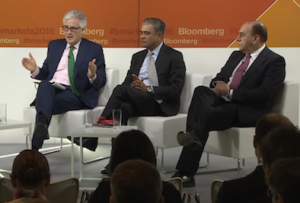The answer is that the private agents who have to hold the non-interest bearing monetary base are the banks (not companies or households) and that the necessary price and quantity adjustments can occur (primarily or wholly) through the pricing and volume of bank loans rather than through the pricing of bank deposits. Permanent Money Finance of a fiscal deficit (PMF) does not require that households or companies willingly hold increased real balances of non-interest-bearing money.
Thus;
Let us suppose that the increase in the money supply which will result from PMF takes the form (wholly or primarily) of an increase in bank deposits (or other bank liabilities)[1] rather than an increase in actual paper currency dollar bills. Consider the impact on the assets, liabilities and profits of the banks:
- On the asset side of the bank’s balance sheets, PMF creates increased reserves held at the central bank. And for PMF to be clearly more stimulative than debt financed deficits, those additional reserves must be remunerated at a zero interest rate [2]. This is because the permanent money created must be irredeemable and non-interest-bearing in order to overcome the Barro style Ricardian equivalence offset which might constrain the effectiveness of debt financed fiscal stimulus[3]
- On the liability side meanwhile, if, as is quite likely, the PMF operation was initially introduced when the interest rate was at the ZLB, these non-interesting bearing assets of the banks could be matched by increased zero interest rate bank deposit liabilities, with households and companies willingly holding increased zero interest rate deposit balances in an environment where all safe interest rates are zero or very low . But as interest rates rise from the ZLB we seem to face two problematic alternatives: either
- oCommercial banks pay positive interest rates for deposits, and make a running loss against their non-interest-bearing reserves at the CB. But this is unsustainable over the long term
- oOr the commercial banks continue to pay zero interest rate on deposits. But households and companies will then attempt to spend their cash balances to buy either goods or alternative assets (e.g. bonds): and while at the level of the overall banking system the deposits cannot be destroyed unless loan volumes also decline (since e.g. all purchases of bonds by one agent place money in the bond seller’s account), the attempt to spend the zero remunerated balances as quickly as possible will produce an increase in the velocity of circulation of money. Eventually the price level and nominal GDP will rise sufficiently to produce an equilibrium in which the zero interest money balances are sufficiently small as a percentage of GDP to be willingly held, but this may be after a period of inflation far greater than the authorities originally hoped to induce
So we seem to have a problem. But in fact the adjustment to the requirement for the commercial banks to hold zero remunerated reserves at the central bank, can come instead (and almost certainly will primarily come) through changes in loan pricing. Thus:
- Suppose that the PMF operation created new zero interest-bearing monetary base equal to 5% of commercial bank assets, with the other 95% being bank loans[4]. And suppose that the policy interest rate, which was zero when the PMF operation was first introduced, subsequently rises to, say, 2%. Suppose moreover that competition between the banks results in all of the 2% increase in policy interest rates being reflected in the average price paid for bank deposits or other bank liabilities
- In this situation the banks will in any case have to reprice their loans by +2% to maintain profitability. But they also now face what is effectively a tax, since 5% of their assets are held at the central bank in reserves remunerated at 0%
- The banks can however pass this tax onto private sector by repricing loans not by +2%, but by +2.1%. And the long-term impact of PMF is thus not the ( probably impossible ) phenomenon of households and companies willingly holding much larger real balances of zero interest money, but a slightly higher price of private credit relative to the policy rate than would otherwise occur.
- Note, however, that this does not necessarily mean a higher absolute price of credit than would otherwise occur, since if the CB was worried that the rise in the price of credit by +2.1% (rather than +2.0%) would produce a more contractionary effect than it intended, it could instead increase the policy rate to 1.9% not 2.0%. A slightly slower pace of policy rate increase up from the ZLB , may therefore be a logical complement to the fact that PMF operation creates, thanks to the imposition of permanently zero remunerated reserve balances, a tax on credit intermediation
There are some further complexities which merit exploration. Thus;
- While it is probable that most of the adjustment will come through the loan pricing channel, there may also be some adjustments in deposit pricing relative to the deposit rate , matched by a perhaps slightly lower equilibrium interest rate on long-term bonds [see note 4][5]
- And it should be noted that the size of the increment to loan pricing arising from the tax, is unlikely to increase proportionately as the interest rate rises yet further (e.g. to 5%) since such an increase is only likely to be appropriate in conditions where loan volumes are growing [ see note 5][6]
But the essence of the answer to the question is that:
- The government/CB can create for themselves a permanent non-interest-bearing liability without having to find households and companies who are willing to hold significantly increased real cash balances of non-interest-bearing money.
- And equilibrium over time is achieved primarily by changes in pricing of loans relative to the policy rate, and by a different evolution of the policy interest rate than would otherwise occur
Footnotes
[1] Note that within my model no particular importance should be attached to whether the increase in bank liabilities falls within those categories which we somewhat arbitrarily define to be “money”
[2] This zero remuneration rate can be applied to minimum reserves which the commercial banks are required to hold at the central bank, even when the CB pays a non-zero interest rate on marginal reserves held above the minimum ,or by some other means (e.g. repo market operations) brings market rates in line with the chosen non zero policy rate
[3] In fact , as a forthcoming paper by Willem Buiter will argue, the superior stimulative effect of money finance deficits does not strictly rely on all of the newly created monetary base being zero remunerated, but on the interest rate paid being less than would have been paid on the debt otherwise issued to finance deficits. But it is much easier to understand the essence of the process if we assume that all newly created monetary base is zero interest bearing . And statements to the effect that the central bank might pay a non-zero interest rate, ( with the government therefore facing some future budget requirement to compensate the CB for resulting losses) would complicate the effective management of expectations
[4] Thus, in the UK, to extend the example used earlier: if the Bank of England had financed an increased fiscal deficit of about 2% each year for three years, this would have created around £100 billion of additional permanent non-interest-bearing reserves, and with bank lending UK private sector around £1.9 trillion, this would have amounted to about 5% bank loans plus reserves at the central bank.
[5] Thus suppose that commercial banks, faced with interest rates rising from the ZLB , increase deposit rates by slightly less than 2%. Then there will be a greater incentive to try to use the additional money to buy bonds: but the attempt to do so might in turn marginally reduce bond yields ; and the equilibrium result might be deposit rates which rise by slightly less than the policy rate, and bond yields slightly lower relative to the policy rate than they would otherwise be. The underlying intuition is that given the restrictive impact of (effectively) a tax on bank credit intermediation, equilibrium interest rates compatible with full employment and inflation on target might be slightly lower for all categories of private sector safe asset. But this hypothesis certainly requires further exploration
[6] Thus: if the policy interest rate rose to 5%, and if loan volumes were unchanged or if the required minimum reserve requirement continued to be 5% of loans plus reserves, the effective tax would now need to be offset by an increase in loan prices of 0.25% versus the rate which applied at the ZLB. But an increase in the policy interest rate to 5% will only be likely in circumstances where the economy and private credit are growing robustly. And to ensure that there is no Ricardian equivalence offset to PMF requires that newly created non-interest-bearing monetary base remains permanent in absolute terms, not as a percentage of bank assets. Thus suppose the policy rate rises to 5% over 10 years, during which time nominal GDP and nominal credit grow by 66% (around 5% per annum), then the minimum reserve requirement as a percentage of loans plus reserves falls from 5% to 3%, implying an increment to loan prices of 0.15% (versus the ZLB position ) not 0.25%

